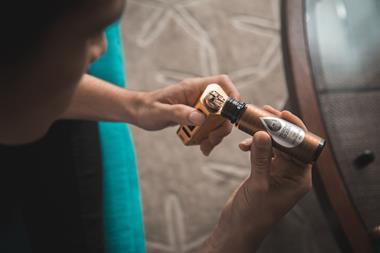While people may be planning to tighten their belts and spend less this year, the traditional trio of spring gift-giving occasions could be just what’s needed to persuade them to part with their cash. The traditional cards, flowers and chocolates ideal for Valentine’s Day (February 14), Mother’s Day (March 22) and Easter (Easter Sunday, April 12) are also a c-store’s domain, so the sector could be in a good position to clean up. According to Georgina Wild, marketing manager at research company HIM, gifting is a huge untapped opportunity in convenience stores. “It doesn’t necessarily require a huge amount of time or effort to create an offer; with a few simple tweaks to your existing range and merchandising you can provide a credible offer ready for your customers,” she says.
When HIM researched 28,000 convenience store shoppers last year, 27% of them claimed they would buy a gift for a friend, partner or family member from a c-store. “This means that there is a demand for a gifting offer,” explains Wild, “but only 4% of all the shoppers we interviewed were actually buying a gift for someone else.”
HIM also found that the majority of gift shoppers make their purchases in the evening and on weekends. And it should come as no great surprise that the most popular gifting occasion is a birthday. When buying a gift for a birthday or other gifting occasion such as Valentine’s Day or Mother’s Day, HIM found that 55% of consumers buy a card, 31% buy a box of chocolates, 11% buy flowers, 8% buy alcohol such as spirits and liqueurs and 4% buy Champagne or wine.
Blooming marvellous
If you are considering stocking flowers Andrea Caldecourt, chief executive of the Flowers & Plants Association, says wholesalers are a good place to start as many offer pre-made bouquets. “Look for those which either have a choice of flowers in one colour or a choice of colours in one flower,” she advises. “Try not to select bunches with both mixed colours and mixed flowers as these are difficult to get right and they appeal to fewer consumers. Our surveys regularly find that neutral-toned bouquets are preferred to brighter clashing ones, particularly at lower price points.
“Garishly patterned multi-coloured sleeves can put customers off too. Look for plain sleeves or those with small, tasteful designs. You want to maximise the opportunities for each bunch to be sold - for love, friendship, sympathy, apology - and the plainer the sleeve, the more occasions that bunch will be appropriate for.”
Flowers need to be displayed well as, more often than not, they are an impulse purchase. Caldecourt says some wholesalers have shop-ready packaging for the convenience market, but with other suppliers you may have to provide your own racking unit.
She adds that the biggest hurdle to overcome is stock turnover. “Fresh flowers are not like baked beans; they cannot be bought in advance and stored somewhere until needed. You need to anticipate how many you think will be sold within (at most) a four-day window, without selling out too fast and losing potential sales, but also without having stock dying, unsold, in your store.”
Flowers need careful handling, too. Caldecourt advises retailers to place them out of the wind, rain, hail, draughts, excess heat or other conditions that could shorten their life or affect their quality.
She also says it’s important to check, at regular intervals each day, that all your flowers are still in the buckets, and the buckets still have water in them. “Customers in a hurry do not always put the bunches back where they found them. Five minutes spent putting all the stems back in water and tidying up the rack is a simple task that could pay dividends in increasing the appeal of the display and ensuring that the quality of the product is maintained.”
If you don’t want the bother of stocking flowers in-store, but would still like to offer them to your customers, then Bunches Florapost has the answer. Its flowers-by-post range is communicated to consumers via in-store leaflets. Retailers fill out a form on their customers’ behalf, take the money, phone through the order and receive commission.
Bunches Florapost head of business services Alex Robinson says Christmas is the busiest time for his company followed by Mother’s Day, Valentine’s Day and then Easter. “For last Valentine’s Day, we dispatched 8,860 orders on February 13 for delivery on the 14th, with our bouquet of 12 Valentino red roses being the most popular product,” he says.
For this year, Bunches offers a single rose with bamboo plus 12 and 24 Valentino rose bouquets with ruscus greenery.
Soft centred
Kraft Foods convenience sales customer director Jack Pipe says spring is particularly important for the confectionery sector as it accounts for almost 40% of annual chocolate confectionery gifting and sharing sales.
“Retailers need to support the confectionery category with special features and in-store displays, focusing on all three calendar events (Valentine’s Day, Mother’s Day and Easter) if they are to maximise sales,” he says. He reckons that with Valentine’s Day falling on a Saturday this year, retailers can expect a flurry of late sales as customers look to their local convenience stores for last-minute gifts. “TNS Gift Track research shows that chocolate is still the second most popular gift after flowers for Valentine’s Day, representing 15% of all gifts, and this looks set to increase as buyers seek a romantic gift on an increasingly tight budget. “Consumers have always given chocolate as a top-up present. However, we’re likely to see even more people choosing confectionery as a main gift or as a treat after a romantic home-cooked dinner this year, as the credit crunch continues to pile pressure on buyers’ budgets. Last year gifts priced under £5 increased their market share to 22.6% compared with 20% in 2007.” He says gifting tablets drove sales growth last year with Toblerone a particular hit. For 2009 the triangular chocolate has seasonal sleeves. Milk 400g features the words ‘To My Love’ while Fruit & Nut 400g has a ‘Fruit and Naughty’ message. The brand will be supported by a £3.1m campaign. Chocolate is also important at Mother’s Day as, according to TNS Gift Track, it is second only to flowers as a gift.
“Mother’s Day confectionery gifts are mainly bought by men at the last minute, so retailers should build big, bold displays in areas such as the front of the store,” says Pipe. “Retailers should also bear in mind that the majority of mums receiving confectionery as a gift are aged over 55, so they need to stock a range of brands to match consumer age profiles.” Iconic gift brand Roses has a new look to celebrate its 70th birthday this year. A new packaging design aims to bring a contemporary feel to the brand, to increase appeal to younger consumers while at the same time not alienating Roses’ core, loyal purchasers. The packaging uses lots of roses with the Roses brand name given its own place on-pack via a gift card on the front.
Card sharp
Most presents come accompanied by a card. According to Mintel, the UK greetings card market is worth about £1.42bn, while the Greeting Card Association says the UK has the most successful greeting card industry in the world with hundreds of publishers producing billions of cards every year. Keynote reports that the average number of greeting cards sent is 55 per person per year, and 85% of all cards are bought by women.
Mintel’s research has found that consumers are demanding higher quality cards, but often at lower prices. Over half of the consumers the company surveyed said that prices were too high, while a quarter said they’d be happy to pay more for special quality hand-crafted or charity cards. Mintel found that £2.99 was the most that shoppers liked to spend on a card, while the average spend was actually £1.95.
The research hints at the risk of competition from e-cards. However, Card Line business development manager Terry Langley says that
UK consumers so far show little sign of shunning traditional cards in favour of electronic greetings on
any large scale.
Card Line aims to make stocking cards easy and produces its own range of greetings cards to cover all seasons and occasions, but its particular strength is in humorous cards. Product is supplied on a consignment basis with merchandising equipment such as spinners supplied free. The company’s staff manage the card sections for retailers, regularly re-merchandising and refreshing the ranges. “Sales are tracked by design at store level - this allows us to review sales and tweak the range to maximise sales,” says Langley.
He says Valentine’s Day has grown into a huge occasion in the UK with about £26m spent on cards and 13 million cards sent. But he advises retailers that ideally any seasonal range should have its own separate display in-store because there is always demand for year-round sellers such as birthday and anniversary cards.
● Move card/gift displays into a prominent position in store at key times (evenings and weekends)
● At the very minimum offer a range of cards. Make sure you include birthday cards as well as blank cards for a multi-purpose solution
● Stock quality cards, not cheap cards
● Dress up bottles of booze with a bow or ribbon during key events
● Move boxes of chocolates near to bottles of Champagne or flowers to create a gifting zone within the store ● Hang gift bags near bottles of wine/Champagne and boxes of chocolates
● Have tissue paper for flowers and offer to remove price tags for customers ● Offer a gift deal such as buy a bottle of wine/Champagne and get a box of chocolates half price. Source: HIM



























No comments yet